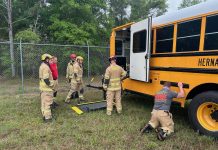While school districts usually have a few transportation glitches the first week of school, New York City has experienced busing issues serious enough to prompt the City Council to hold a special hearing and two legislators to call for new technology on every school bus.
Key officials from the Department of Education and New York City Public Schools, including Executive Director of Transportation Alexandra Robinson, attended the City Council hearing Oct. 10 to consider the problems plaguing the school bus system. Operated by the DOE’s Office of Pupil Transportation, the system is the largest transportation operation in North America.
The system is complicated because there are different programs for special education students and other students, plus different requirements for different grades. In addition, the education system allows students to attend schools across the city, no matter the distance.
Busing problems reported early in this school year include cases of students missing school due to lack of transportation or arriving late, and special needs children riding the bus for hours in violation of time limits specified in their IEP.
In one highly publicized incident, a 3-year-old autistic boy from Brooklyn was hysterical after enduring a five-hour bus ride home on the first day of school.
Parents of special needs students were disappointed when some officials, such as Deputy Chancellor of Operations Kathleen Grimm, reportedly left the hearing before hearing their testimony.
Issues related to the hearing impaired arose this week when families at P.S. 47 challenged the DOE over a policy that prevents two sisters from riding the same bus to the same school. One sister is hearing impaired and physically challenged, and the parents contend that her well-being is at stake if her sister cannot ride with her. In New York, students in grades 7 through 12 generally do not get bus service.
Safety & Cost Concerns
Other stories in the city making headlines include the school bus driver who crashed into a house on Long Island earlier this month. Frederick Flowers, 66, was charged with multiple counts of DWI after passing out and swerving into a house with students onboard, and last week Robert Stundis, 48, was arrested for allegedly driving a school bus drunk.
In response, Nassau County District Attorney Kathleen Rice and state Sen. Charles Fuschillo this week pushed a bill that would require ignition interlock devices on all school buses in the state. Ignition interlock devices require the driver to blow into a breathalyzer in order to start the vehicle. The vehicle will not start if alcohol is detected. If passed, the law would be the first of its kind in the nation.
“School bus drivers literally hold students’ lives in their hands,” said Fuschillo, the chairman of the Senate’s Transportation Committee. “We have strong laws to hold bus drivers accountable after they have been drinking; now we need to prevent them from even having the chance to drive drunk behind the wheel of a bus.”
Peter Mannella, executive director of the New York Association for Pupil Transportation, gave a presentation on the inherent safety and efficiency of the school bus to the governor’s new N.Y. Education Reform Commission Oct. 11. He cautioned that New York should not follow the lead of other states that are cutting back on service, training and safety inspections or simply telling school districts to absorb all the costs of transportation.
“Rather than looking for ways to reduce school transportation services, we recommend that the state work with school leaders and school transportation professionals to determine efficient ways to ensure the continuity and consistency of this valuable resource,” he said.
Mannella disputed the premise that delivering school transportation is expensive, noting that the average cost per child is $6.76 per school day. This is derived by dividing the number of students transported (2.3 million) by the amount it costs ($2.8 billion per SED estimate) to provide transportation across the state and then dividing by 180 school days.
The cost and efficiency of scheduling and routing are complicated by several factors, he stated, including special education routes and assignment of attendants, lack of coordination in bell times and calendars, lower incidence private school routes, BOCES and career education routes and last-minute changes in classes and daily schedules.
“We simply cannot reduce costs appreciably while providing customized routes for students. Transportation systems and services economize by streamlining routes and reducing or eliminating customization of services,” added Mannella.













